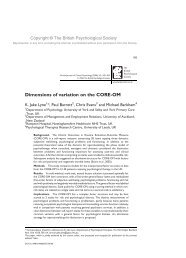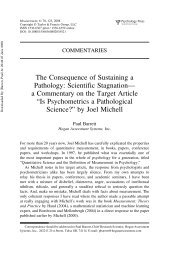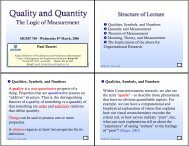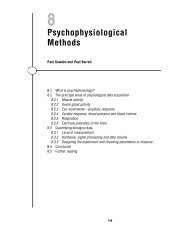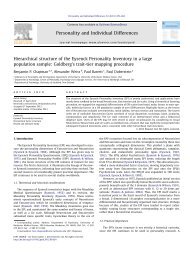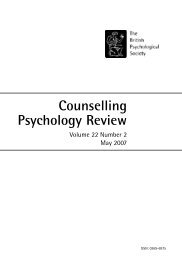What If There Were No Psychometrics?: Constructs ... - Paul Barrett
What If There Were No Psychometrics?: Constructs ... - Paul Barrett
What If There Were No Psychometrics?: Constructs ... - Paul Barrett
Create successful ePaper yourself
Turn your PDF publications into a flip-book with our unique Google optimized e-Paper software.
140 BARRETT<br />
In D. Kaplan (Ed.), The Sage handbook of quantitative methodology for<br />
the social sciences (pp. 391–408). Thousand Oaks, CA: Sage.<br />
Goldberg, L. R. (1990). An alternative “description of personality”: The<br />
Big-Five factor structure. Journal of Personality and Social Psychology,<br />
59, 1216–1229.<br />
Gray, J. (1982). The neuropsychology of anxiety. Oxford, England: Clarendon.<br />
Harlow, L. L., Mulaik, S. A., & Steiger, J. H. (Eds.). (1997). <strong>What</strong> if there were<br />
no significance tests. Mahwah, NJ: Lawrence Erlbaum Associates, Inc.<br />
Kelley, T. L. (1929). Scientific method. Chicago: Ohio State University Press.<br />
Maraun, M. D. (1997). Appearance and reality: Is the Big Five the structure<br />
of trait descriptors?. Personality and Individual Differences, 22, 629–647.<br />
Maraun, M. D. (1998). Measurement as a normative practice: Implications<br />
of Wittgenstein’s philosophy for measurement in psychology. Theory &<br />
Psychology, 8, 435–461.<br />
McGrath, R. E. (2005/this issue). Conceptual complexity and construct validity.<br />
Journal of Personality Assessment, 85, 112–124.<br />
Meehl, P. E. (1990). Why summaries of research on psychological theories<br />
are often uninterpretable. Psychological Reports, 66, 195–244.<br />
Michell, J. (1999). Measurement in psychology: Critical history of methodological<br />
concept. Cambridge, England: Cambridge University Press.<br />
Michell, J. (2001). Teaching and misteaching measurement in psychology.<br />
Australian Psychologist, 36, 211–217.<br />
Michell, J. (2004). Item response models, pathological science, and the<br />
shape of error. Theory and Psychology, 14, 121–129.<br />
Parsons, C. (1990). The structuralist view of mathematical objects. Synthese,<br />
84, 303–346.<br />
Plutchik, R., & Conte, H. R.(Eds.). (1997). Circumplex models of personality<br />
and emotions. Washington, DC: American Psychological Association.<br />
Rasch, G. (1960). Probabilistic models for some intelligence and attainment<br />
tests. Copenhagen, Denmark: Danish Institute for Educational Research.<br />
Resnick, M. D. (1997). Mathematics as a science of patterns. Oxford, England:<br />
Clarendon.<br />
Salgado, J. (2003). Predicting job performance using FFM and non-FFM<br />
personality measures. Journal of Occupational and Organizational Psychology,<br />
76, 323–346.<br />
Thomson, W. (1891). Popular lectures and addresses (Vol. 1). London:<br />
MacMilllan.<br />
Weinberger, D. A., Schwartz, G. E., & Davidson, J. R. (1979) Low-anxious,<br />
high-anxious, and repressive coping styles: Psychometric patterns and behavioural<br />
and physiological responses to stress. Journal of Abnormal Psychology,<br />
88, 369–380.<br />
Wilensky, U. (1999). NetLogo [Computer software]. Evanston, IL: Center<br />
for Connected Learning and Computer-Based Modeling, <strong>No</strong>rthwestern<br />
University, Retrieved from http://ccl.northwestern.edu/netlogo<br />
Wittmann, W. W. (1988). Multivariate reliability theory. Principles of symmetry<br />
and successful validation strategies. In J. R. Nesselroade & R. B.<br />
Cattell (Eds.), Handbook of multivariate experimental psychology (2nd<br />
ed., pp. 505–560). New York: Plenum.<br />
Wittman, W. W. (2003). How to fool yourself with experiments in testing theories<br />
in program evaluation and psychological research. Retrieved August<br />
8, 2005, from http://www.psychologie.uni-mannheim.de/psycho2/<br />
psycho2.en.php3?page=publi/papers.en.htm&cat=publi<br />
Wittmann, W. W., & Süb. (1997, July). Challenging G-mania in intelligence<br />
research: Answers not given, due to questions not asked. Paper presented<br />
at the ISSID Conference, Aarhus, Denmark. Retrieved August 9, 2005,<br />
from www.psychologie.unimannheim.de/psycho2/psycho2.en.php3?page<br />
=publi/papers.en.htm&cat=publi<br />
Wood, R. (1978). Fitting the Rasch model: A heady tale. British Journal of<br />
Mathematical and Statistical Psychology, 31, 27–32.<br />
<strong>Paul</strong> <strong>Barrett</strong><br />
Department of Management and Employment Relations<br />
Commerce Building C<br />
18 Symonds Street<br />
Auckland 1 New Zealand<br />
Email: paul.barrett@auckland.ac.nz<br />
Received February 19, 2005



